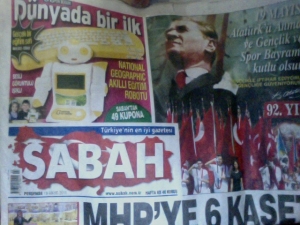by Diego Salvatierra
Sanliurfa clearly looks quite different from Istanbul. One might say it feels more “Middle Eastern,” as if we were already south of the border. But the omnipresent image of Mustafa Kemal Ataturk, the father of modern Turkey, reminds us that we are still within his country. Ataturk, who declared the Turkish Republic in 1923, is honored throughout the nation. His portrait adorns all public buildings and many private ones, from restaurants to homes; it is even said that no town in Turkey lacks a statue of him. He seems like Washington, Lincoln, and JFK wrapped into one – both a founder and a reformer, whose sayings and speeches are still a source of inspiration. More controversially, “insults to his memory” are prohibited by Turkish law.
On May 19th, we witnessed the peak of Ataturk praise. May 19thwas originally designated by Ataturk to commemorate the beginning of his liberation of Turkey from occupation in 1919. After Ataturk’s death in 1938, it was expanded to honor the founder himself, and is know known as the “Commemoration of Ataturk, Youth, and Sports Day.” The first things I noticed, as we passed through various towns on our way to Gaziantep, were the massive banners with his face in the city plazas. Red and white, the colors of the Republic, were everywhere. When we stopped at the aptly named Ataturk Dam, the largest in the country, I took a brief glance at a newspaper stand. Most, if not all, Turkish newspapers prominently featured his image. When I turned on my hotel TV that night, I found that channel after channel displayed his face on a corner, along with a waving Turkish flag.

The upcoming election has spurred heated debate between the opposition People’s Republican Party (CHP), which claims to defend Ataturk’s legacy of strong secularism, among other things, and the ruling Justice and Development Party (AKP), sometimes seen as departing from Ataturk’s vision. In light of this, one would expect Ataturk to be a divisive figure. This is true to a certain extent. But if we judge from the displays on May 19th, his role as a symbol of Turkish patriotism looks alive and well. Whether this display comes from genuine veneration or simply out of habit (or legal obligation?) is hard to say.